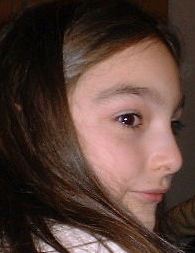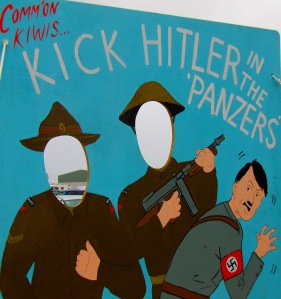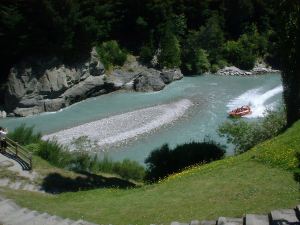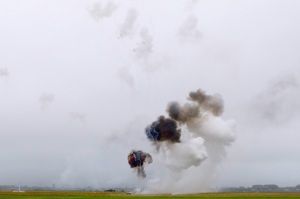The streets of Edinburgh were strange. Alien. I felt disconnected from the world as we walked, hardly aware of my mum holding my hand. Something was wrong. They hadn’t said anything, my mum and dad, but my stomach was attacking itself in warning. That, and I was hungry.
Dad was on edge. Every time we crossed a road he glared left and right as though it was the city’s fault that he wasn’t where he needed to be. A conference, they’d said. ‘Daddy has to go to a conference.’ Apparently, he didn’t know how to get there. He’d started using car-words. (Words that only Daddy was allowed to say and only in the car.)
My little sister was oblivious to this developing turmoil. She kept running ahead and shouting, “PACHY!” – much to my mum’s embarrassment. (She didn’t realise she was being racist. Her imaginary friend was a pachycephalosaurus.) She didn’t even know what a conference was. I only had a vague idea. It was something frightening.

My family in Retford, the year before we moved to New Zealand
Eventually, sick of my whinging, Dad told Mum to take ‘the girls’ to get some food – he’d find the conference on his own. I was relieved we no longer had to hurry after him, but still confused. Why did Dad have to go to a conference? What was the conference for? Weren’t we supposed to be on holiday?
It had been quite a nice holiday so far. We’d driven from our home in Retford, up through Yorkshire, and visited Lindisfarne before arriving in Edinburgh. I’d never been to Scotland before, so I was all excited. Then the conference. The conference that I had yet to receive a straight answer about. ‘It’s something for teachers’ was all I’d managed to glean. (Dad was a teacher.)
It wasn’t until that evening that I’d learn our whole holiday was a sham. That we wouldn’t have come at all if it hadn’t been for the conference. The sense of betrayal the nine-year-old me felt at that realisation, however, was nothing compared to what was to come.

The nine-year-old me
We were in an Italian restaurant. All the tables had red and white checked tablecloths and candles in bottles that were obscured by many layers of hardened dribbles. My dad was angry with the food. He thought it was ‘pap’, but my mum thought it was fine. My sister was ‘feeding’ Pachy. Then my parents looked at each other and looked at me, and they told me the truth.
The conference was for British teachers who wanted to teach in New Zealand.
“New Zealand?” I said. “You mean that little, triangle bit at the bottom of Australia?”
“No, Abby, that’s Tasmania,” Dad said.
“But you were very close. Well done,” Mum added.
“But…” I was engulfed in a rising tide of dread. “But you can’t teach in New Zealand. We live in Retford.”
“Abby –”
“Unless you get a really fast plane every morning –”
“Abby. We are going to live in New Zealand.”
Bam. My eyes and lips were trembling. The implications of moving were stuck in my throat, all pushing to get out and blocking the way in the process. “H-how far away is it?”
“About twelve thousand miles,” Dad said.
“Tw-tw-” It was no good. Tears were starting now. My world was falling apart and my heart was breaking. The restaurant was spinning. I remember the red and white checks blurring together. “But what about my friends? What about Elizabeth?” My voice got shriller and shriller. People at other tables were staring. “What about dancing? And Grandma?”
“Sit down, Abby,” Mum said. (I hadn’t realised I was standing.)
“No!” I cried. The idea of having everything I knew and loved torn away from me… my best friend… my dancing lessons… and to be replaced with New Zealand. New Zealand was a wasteland!
“Abby –”
“I’m not moving to New Zealand!” I shrieked. “You can’t make me!” And with that I ran into the toilets.
I kept running until I was in a corner by a hand dryer and then I screamed. Conscious of the noise, I slammed my fist into the hand dryer to turn it on. Accompanied by the roar of hot air, I sobbed and sobbed.
Mum came in and put a hand on my shoulder. I flinched. “We are going to New Zealand,” she said.
I couldn’t take it. I ran away again, this time out onto the dark Edinburgh street. At least I had the sense not to stray far from the illuminated restaurant window, tempted as I was to get myself lost. When I went back inside, it wasn’t because I’d forgiven my parents; it was because I was cold.
Mum and Dad didn’t want Grandma to know that Dad was applying for jobs in New Zealand. They didn’t want to worry her. They’d only tell her if – when – he actually got a job. It was a pretty big secret for a nine-year-old to keep.
Grandma lived just round the corner from us. Ours was a neighbourhood of Victorian terraces, quite depressing compared to what we’ve become used to in New Zealand, but I’ll always remember it fondly. Grandma was short and plump, and she always wore cardigans and stockings and called me ‘duck’. She died last year, but at least she’d been able to visit us in New Zealand twice. She’d never even been out of Britain before that, (well, except to Jersey,) and she hated anything foreign.

The alley behind my gran’s terrace
Across the street from my gran, there lived a girl who always wanted me to come out and play with her. I did, even though I would have often preferred to have stayed at home on my own, reading or writing. One day, I was sitting in the alley behind my gran’s terrace when she found me. Her cheerfulness intruded upon my artistic misery.
“’Iya, Abby,” she said. “Wanna go play on the railway bridge?” When I didn’t respond, she tugged my arm. “Oh, come on! The nettles aren’t bad. You just have to step on them.”
“We’re moving to New Zealand.” That stopped her dead.
Her face slackened. “You’re… you’re moving? Like… away?”
“Yeah,” I said.
“But you can’t! I mean… Where’s New Zealand?”
“You’ve never heard of New Zealand?” I asked, taking a nine-year-old’s delight in her ignorance. “Duh – it’s in Australia.”
“Australia?!” she cried. “But that’s full of kangaroos and aberrations and… and it’s the other side of the world!”
“Yeah. Me dad said it were twelve million miles away. Or summat like that,” I said.
“Wow,” she said, sinking back against the wall. “I’m really going to miss you.”
“No, you’re not,” I said.
“Yes, I am!” she whined.
“No, you’re not,” I said, “because I’m not going.”
“What do you mean you’re not going?” she asked. “How can you not go when you parents –”
“I’ll run away from home before I go!” My voice echoed around the alleyway.
“Wow,” she said. “Where’re you going to go?”
“Grandma’s,” I said.
“But int y’ grandma’s just round the corner?” she said.
“Exactly.” I grinned smugly. “It’s the last place they’d ever think of looking for me.”

A photo of our house, taken from the railway bridge
I’m not sure how long I seriously entertained this notion. I seem to remember wanting to run away then realising that it would soon be tea time, and, of course, there was no sense in running away before having tea. Anyway, my friend and I did end up going to the railway bridge. (It was right next to my house.) As we sat there, legs dangling over the tracks, she asked, “Are there trains in New Zealand?”
I didn’t know. I didn’t think so. There probably wasn’t electricity either.
After a while, my friend sighed. “I hate it here,” she said.
“Why?” I asked.
“Everything’s just so… grey. I bet New Zealand isn’t grey.”
“No,” I said. “It’s green.”
“How do you know?” she asked.
“Mum and Dad keep saying so.” I shrugged.
When we got bored of playing on the railway bridge, we went to sit against ‘our’ wall. It was the wall of an alley that ran in front of a row of bungalows out the back of my house. In one of the bungalows, there lived an old lady called Betty. (She was a bit gaga so we called her Batty.) She often saw us and brought us sweets, which we ate even though they were years out of date.
Now, this next part of the story is a bit of a guess. You see, at some point, Betty told my grandma that my mum and dad were planning on jetting off to New Zealand without telling her. This, understandably, made my grandma very upset, and there was a lot of explaining to do. What I think happened is that Betty overhead my friend and I talking and jumped to conclusions.
So it was that my parents’ plan about not telling Gran that we were moving to New Zealand until my dad actually had a job was ruined. As it happened, we were at my gran’s house when Dad got the call on his clunky ’90s cell phone. My mum screamed and hugged him like an excited teenager and my gran burst into tears.
I was scared stiff. It was happening. It was confirmed.
We were moving to a place called Waiuku. Waiuku, my dad explained, was a Maori name. It meant ‘muddy waters’.
“But that’s stupid!” I said. “Who’d name a town ‘muddy waters’?” (Later, I realised with a surge of satisfaction that the name of the town I wanted so desperately to stay in, Retford, means ‘muddy waters’ too! It comes from the Anglo-Saxon ‘Red Ford’ – when cattle were driven across the ford, they churned up the mud at the bottom, turning the water red. How cool is that? It was like fate.)

My last Christmas in England
The next few months went by in a blur. Dad’s job was to start at the beginning of the coming year, 2001, because school years in New Zealand start in February, not September. This presented a problem for my sister and I, because we were still halfway through our school year. (I was in Year Five; Lucie was in Year Two.) In the end, Dad went to New Zealand six months ahead of us, leaving Mum to sell our house.
Saying goodbye to Dad at Manchester Airport was horrible. It was the first time my family had been separated. It didn’t hit me that I should be sad until we were hugging him at the gate, and everyone else was crying. I suddenly realised that six months was a long time. I howled with the rest of them.
School was weird for me after that. Knowing I was leaving soon made everything seem a bit meaningless. I remember my class did an Aboriginal art project, and I got all excited and asked Dad to send me some pictures of Maori art, figuring they’d be similar. (How wrong I was.)
Then the time came for all our stuff to be shipped off. The men from Britannia Movers International arrived. I liked their logo – the classical goddess Britannia with her Union Jack shield – but it took great restraint for me not scream at them, “Put that back!” My life was literally disappearing around me.
 I felt like I was fading away. Like Marty McFly at the end of Back to the Future. My last day of school, I sat on a side bench in Mr Lilley’s classroom and watched the rest of the class as though from under water. The headmistress, (ironically named Mrs Britain,) approached to offer me luck and words of comfort. Unfortunately, I can’t remember what those words were, only that they seemed significant and grownup at the time.
I felt like I was fading away. Like Marty McFly at the end of Back to the Future. My last day of school, I sat on a side bench in Mr Lilley’s classroom and watched the rest of the class as though from under water. The headmistress, (ironically named Mrs Britain,) approached to offer me luck and words of comfort. Unfortunately, I can’t remember what those words were, only that they seemed significant and grownup at the time.
Then the school day was over. I panicked. It had come too fast. Never again would I have a lesson at this school, or see any of these people. I had a few photographs with various groups. (A good delaying tactic.) Then everyone started drifting away. Only my best friend, Elizabeth, was left. I knew I’d miss her far more than she’d miss me. I just wanted to cling to her and never let go.
I hugged her and hugged her, but all too soon my mum pulled me away. It was time to go. We lived in opposite directions from the school. We started walking down Bracken Lane in those respective directions. Then I looked back. She didn’t. I watched her back get smaller and smaller. She was wearing a light blue jacket. I know because the image was burned onto my mind, and I recalled it so often during my lonely times in New Zealand that now I’ll remember it until I die. When I realised that she wasn’t going to look back, I started to cry.
Not just cry. I had a full-on tantrum whilst walking home from school. My mum wanted me to be quiet – it was shameful – but I didn’t care. I had so much grief inside me that I just had to get out. I think that was the last tantrum of my childhood.
The horrible goodbyes weren’t over. Next we had to say goodbye to Grandma, and we didn’t know if she’d be able to visit us, as she was terrified of flying. Then Uncle Damon drove us to Nana’s house in Ellesmere Port, Cheshire, and we had to say goodbye to Uncle Damon. My nana, who now lives with us in New Zealand, had prepared something very special for us.

Chester
It was our last night in England – the last night of the poms, as my dad later joked – and Nana had hired a limousine to take us on a tour round Chester, and then to our favourite restaurant. It was wonderful. I felt like I was famous in my blue, fringed, ’20s-style dress, drinking from a champagne flute on velvet cushions.
The windows were tinted, so no one could see who was in the limo, and people on the street started taking photographs of us. My nana wound her window down a bit so she could do a regal wave. What a way to spend our last night, in true Britannia style!
Then, of course, it was our turn to fly out of Manchester Airport. I don’t envy my mum’s task of getting herself, two little girls, and all three sets of our luggage across the world in one piece, but she did it. We even had a night enjoying the sights in Singapore on the way. Then we were in New Zealand…
My first impression? I was kind of zonked out from the flight, so I didn’t notice much. New Zealand seemed pretty much the same as Britain, rather boringly. At least it wasn’t the backward wasteland I’d feared. The light was different, though. New Zealand was bathed in warm light. I can still see it, what I saw from the back of Dad’s car as he drove us from Auckland Airport to our new home. It was a strange light, the light of an alien world, but it was comforting nonetheless.
That was twelve years ago. Nearly thirteen.

Sunny New Zealand
I’m twenty-two now. I remember what happened then in such great detail, not only because I replayed the events over and over – clung to them rather sadly – but because I wrote the story of what happened at the time. The conversations above are exerts of that story, not made up. It’s funny looking back at what a melodramatic brat I was! (And how I thought New Zealand was pretty much Australia. Sorry!)
Of course, I’m glad now that we moved to New Zealand. I wouldn’t have it any other way. New Zealand is a far better country to grow up in than England. At the time, though, I thought I’d never forgive my parents. The move undoubtedly had a massive psychological impact – you can read about that in The Existential Crisis of the Immigrant Child – and, although I still don’t consider myself a true Kiwi, I love New Zealand and want to grow old here.
For the next part of the story, in which I recount my first day at my new school in New Zealand and my brief return to England years later, see Kiwis, Kiwis and Kiwis: The People of New Zealand.

53.321356
-0.945503





































